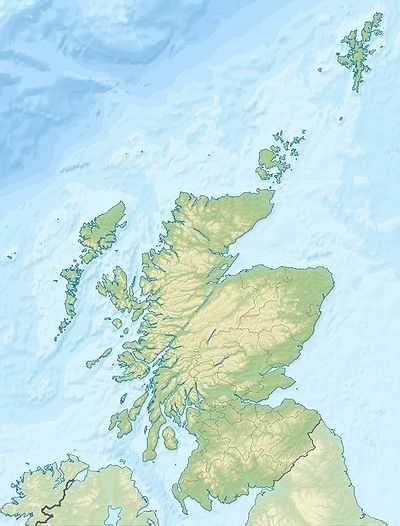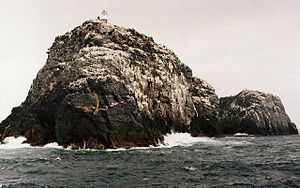Sula Sgeir
| Location | |
|---|---|
 Sula Sgeir Sula Sgeir shown within Scotland | |
| Names | |
| Gaelic name | Sula Sgeir |
| Norse name | Súlasker |
| Meaning of name | Gannet Skerry |
| Physical geography | |
| Island group | North Atlantic |
| Area | 15 ha[1] |
| Political geography | |
| Sovereign state | United Kingdom |
| Country | Scotland |
| Council area | Comhairle nan Eilean Siar |
| Demographics | |
| Population | 0 |
| References | [2][3][4] |

Sula Sgeir is a small, uninhabited Scottish island in the North Atlantic, 18 kilometres (11 mi) west of North Rona. One of the most remote islands of the British Isles, it lies more than forty miles north of Lewis and is best known for its population of gannets.
Although seemingly very inhospitable to humans, there is a ruined stone bothy called Taigh Beannaichte (Blessed House) on the east headland Sgeir an Teampaill. The hard gneiss rock of which the island is made splits into long pieces, which are excellent for building bothies and cairns, but the hard rough boulders and sharp rocks make for difficult walking.
The sea has burrowed right through the southern part of the island in a series of interconnected and spectacular caves which can be explored in calm weather by inflatable. The small lighthouse on the south end at Sròn na Lice is regularly damaged by the huge seas which break right over the rock during Atlantic storms.
Despite this there is a surprising amount of vegetation, and the thrift is especially colourful in June, which is probably the best month to visit.[5]
Etymology
The modern name is from the Old Norse súla, "gannet" and sker, "skerry".[3] In the 16th century Dean Munro referred to the island as "Suilskeray".[6] Macculloch's 1819 Description refers to "Sulisker",[7] an Anglicised spelling that is still occasionally used.[8]
Legend
St Ronan's sister, Brenhilda, is supposed to have stayed here for some time, leaving him on Rona, only to be found dead in a bothy with a shag’s nest in her ribcage.

History
Sula Sgeir has a special place in the seafaring history of the men of the Ness district on Lewis. Dean Munro visited the Hebrides in 1549 and his is one of the earliest accounts written about the Western Isles. His description of Sula Sgeir mentions that the men of Ness sailed in their small craft to "fetche hame thair boatful of dry wild fowls with wild fowl fedderi".[6] How long before 1549 the Nessmen sailed to Sula Sgeir each year to collect the young gannets for food and feathers is not known, but it may be assumed that it was a tradition for centuries. That tradition is still carried on today. A report written in 1797 says:
- "There is in Ness a most venturous set of people who for a few years back, at the hazard of their lives, went there in an open six-oared boat without even the aid of a compass." [10]
The flesh of the young gannet or guga is regarded as a delicacy in Ness today though, for others, it is an acquired taste. It was a popular meat in earlier times in Scotland. In the sixteenth century it was served at the tables of Scots kings and was a favourite with the wealthy as a ’whet’ or appetizer before main meals. In the autumn of each year, a group of 10 Nessmen set sail for Sula Sgeir to kill a maximum of 2,000 young birds. They set up residence for about two weeks in stone bothys. Working in pairs, the men take the fledglings from their nests with poles, catching them around the neck with a rope noose, then killing the birds with a blow to the head. They bring home their catch to meet an eager crowd of customers. The demand is often so great that the birds have to be rationed out to ensure that each person does not go without a taste of guga. In 2009, a single guga fetched £16.[11]
The Sula Sgeir hunt, which would otherwise be illegal under the Wildlife and Countryside Act 1981, receives an annual licence from the government, which allows it to continue. Scottish Natural Heritage, which is now responsible for granting the licence, states that the hunt is sustainable, although it has been criticised by animal welfare groups. The Scottish SPCA describes it as "barbaric and inhumane" and believes it causes unnecessary suffering to the birds, with many taking several blows to be killed.[12][13]
Fauna
There are some 5,000 breeding pairs of gannets on Sula Sgeir, which they share with other bird species such as Black-legged Kittiwakes, guillemots, puffins, fulmars and at present what is believed to be the only resident albatross in the North Atlantic.[14]
Together with North Rona, Sula Sgeir was declared a national nature reserve in 1956 because of its importance for birdlife and grey seal breeding. The reserve is now managed by Scottish Natural Heritage and is the most remote and least-visited national nature reserve in Britain.[15]
Media and the arts
- In 2009 Director Mike Day sailed with the guga hunters to Sula Sgeir and filmed on the island over a 10-day period. The resulting film was commissioned by BBC Scotland and broadcast in January 2010.[16][17][18]
- Award winning Scottish writer Peter May uses the setting of Sula Sgeir describing the annual expedition in his crime story "The Blackhouse" in 2011 (first published in a French translation in 2009).[19]
- Robert Macfarlane describes the hunt at Sula Sgeir in his book The Old Ways: A Journey On Foot. He does not participate in the hunt, but circumnavigates the rock in a small craft at the same time as the arrival of the hunters: '[W]e saw the guga men standing on the steep rock that slopes to the landing point. [...] They looked out at us, unsmiling. [...] They knew the boat, and they knew Ian [Macfarlane's captain], but the implication was clear enough: Keep away, this is our day, our rock.'[20]
See also
Notes
- ↑ A figure of 1.244 km2 for the land area of Rona and Sula Sgeir is provided by Wood, L. J. (2007). MPA Global "Rona and Sula Sgeir" mpaglobal.org. Retrieved 8 September 2009. Haswell Smith (2004) p. 326 gives 109 ha for North Rona. Sula Sgeir is therefore c.15.4 ha.
- ↑ General Register Office for Scotland (28 November 2003) Scotland's Census 2001 – Occasional Paper No 10: Statistics for Inhabited Islands. Retrieved 26 February 2012.
- ↑ 3.0 3.1 Haswell-Smith (2004) p. 315
- ↑ Ordnance Survey. Get-a-map (Map). 1:25,000. Leisure. Ordinance Survey. Retrieved 21 August 2013.
- ↑ Innsegall online guide: Rona and Sula Sgeir Retrieved 29 June 2007.
- ↑ 6.0 6.1 Monro (1549) "Suilskeray" no. 162
- ↑ Macculloch (1819) p. 204.
- ↑ Scoresby (2009) p. 67
- ↑ Harvie-Brown, J. A. & Buckley, T. E. (1889), A Vertebrate Fauna of the Outer Hebrides. David Douglas. Edinburgh. Facing P. XLVI.
- ↑ Statistical Account of Scotland. Edinburgh. 1797. pp. 271–272.
- ↑ Culture Hebrides: Guga by Scott Hatton
- ↑ First catch your gannet... then prepare for a challenge to nose and tastebuds (Guardian)
- ↑ Cliffhanger for a bloody tradition as last of Scotland's gannet hunters set sail (Guardian)
- ↑ BBC News (9 May 2007) No romance for lovesick albatross Retrieved 29 June 2007.
- ↑ SNH Rona and Sula Sgeir Reserve Retrieved 29 June 2007.
- ↑ http://www.bbc.co.uk/scotland/nature/the_guga_hunters_of_ness_creating_the_programme.shtml
- ↑ https://vimeo.com/ondemand/gugahunters
- ↑ http://intrepidcinema.com/Intrepid_Cinema/Home.html
- ↑ "The Blackhouse by Peter May". Undiscovered Scotland. Retrieved 20 August 2014.
- ↑ Robert Macfarlane, 'The Old Ways: A Journey on Foot', Hamish Hamilton 2012, p. 136.
References
- Haswell-Smith, Hamish (2004). The Scottish Islands. Edinburgh: Canongate. ISBN 978-1-84195-454-7.
- Macculloch, John (1819) A Description of the Western Islands of Scotland, Including the Isle of Man. Constable.
- Monro, Sir Donald (1549) Description of the Western Isles of Scotland. William Auld. Edinburgh - 1774 edition.
- Scoresby, William (2009). The Arctic Whaling Journals of William Scoresby the Younger. Ashgate Publishing.
Further reading
- Atkinson, Robert (1995). Island going. Birlinn. ISBN 1-874744-31-9.
- Beatty, John; Brian Jackman (1992). Sula: Seabird Hunters of Lewis. Michael Joseph. ISBN 0-7181-3634-9.
- Murray, Donald S. (2008). The Guga Hunters. Birlinn. ISBN 1-84158-684-6.
External links
| Wikimedia Commons has media related to Sula Sgeir. |
- News article on 1912 journey (via Archive.org)
- Charles Tait Photographs of Sula Sgeir
| |||||||||||||||||||||||||||||||||